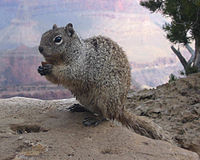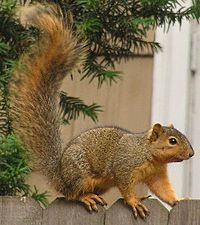Red and white giant flying squirrel
| Red and white giant flying squirrel | |
|---|---|

| |
| Scientific classification | |
| Kingdom: | |
| Phylum: | |
| Class: | |
| Order: | |
| Family: | |
| Genus: | |
| Species: | P. alborufus
|
| Binomial name | |
| Petaurista alborufus (Milne-Edwards, 1870)
| |
The red and white giant flying squirrel (Petaurista alborufus) is a species of rodent in the family Sciuridae. It is the largest species of giant squirrel and has blue eyes.[2] It is also known as the Chinese giant flying squirrel. At over a meter long including its tail, the red and white giant flying squirrel is the largest of its kind. Endemic to central and southern China and Taiwan, they inhabit dense hillside forests in mountainous terrain. They spend their days sleeping, emerging after sundown to forage in the trees. Their diet consists primarily of nuts and fruits, but also includes leafy vegetation as well as some insects and their larvae. Red and white giants move between trees by gliding, typically over distances of about 10–20 meters. This squirrel has a wide range and is relatively common, and the International Union for Conservation of Nature lists it as being of "least concern".
Gliding
Gliding is accomplished with the help of a parachute-like membrane called a patagium. Before taking off, flying squirrels bob and rotate their heads to gauge the route, and then leap into the air, spreading their patagia between cartilaginous spurs on their wrists and ankles. Small adjustments to these spurs give them some control over their speed and direction. Their flattened tails also aid in steering. As their destination nears, they pull upright, prepare their padded feet to cushion the shock of impact, and ready their sharp claws to grip the bark. Gliding is an efficient way to travel but maneuverability in the air is limited. By keeping nocturnal habits, flying squirrels avoid predation by more skilled fliers, such as hawks and eagles. Owls however, still pose a threat.
The are 44 species of flying squirrel worldwide. The fact that most of them live in Asia has led to the hypothesis that they originated there. Only two species are found in the Americas: the Northern flying squirrel lives in deciduous and mixed woods all across Canada as well as down into the Pacific Northwest and Sierra Nevada; the Southern flying squirrel lives in the Eastern half of North America from southern Canada down to Florida, with isolated pockets in Central America.
Gliding has evolved independently in a variety of arboreal animals. Among mammals, there are the marsupial gliding possums of Australia, the colugos of SE Asia, and the scaly-tailed flying squirrels of Africa. Each group glides in a slightly different way, with their patagia being controlled by different morphological adaptations. In some marsupial gliders for example, the patagium attaches at the elbows, whereas in colugos it extends into webbed digits. The fact that all flying squirrels are “wrist gliders” with shared wrist anatomy suggests that they are all descended from a common ancestor, presumably some sort of primitive tree squirrel. Non-mammalian arboreal gliders include frogs, geckos, snakes, lizards, and even ants.
Ecology
The giant flying squirrel is an omnivore, feeding on nuts, fruits, leaves, insects and insect larvae.
The giant flying squirrel is often found in mountain areas, they nest in hollow trees. They move between the trees of their ecosystem by gliding by use of a patagium, typically over distances of 10–20 meters although glides of up to 400 meters longer have been observed when they happen to be traveling downhill.
Status
This species has a wide distribution and a presumed large population, it occurs in many protected areas, and the International Union for Conservation of Nature has rated it as being of "least concern".[1]
References
- ^ a b Template:IUCN2008
- ^ Doucette, Dan (2012-03-24). "Red and White Giant Flying Squirrel". Project Noah. Retrieved 2012-04-14.




